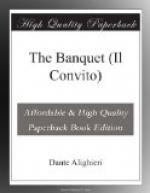I say, then, in the first place: “My Song, it seems you speak this to oppose The saying of a sister Song of mine.” For the sake of similitude, I say sister; for as that woman is called a sister who is born of the same father, so may a man call that work a sister which is wrought by the same worker; for our work is in some degree a thing begotten. And I say why it seems opposed or contrary to that sister Song, saying: “This lovely Lady whom you count divine, Your sister called disdainful and morose.” This accusation being affirmed, I proceed to the excuse, by quoting an example, wherein the Truth is quite opposite to the appearance of Truth, and it is quite possible to take the false semblance of Truth for Truth itself, regarding Truth itself as Falsehood. I say: “Though Heaven, you know, is ever high and pure, Men’s eyes may fail, and find a star obscure;” where it is shown that it is the property of colour and light to be visible, as Aristotle affirms in the second book Of the Soul and in the book on Sense and Sensation. Other things, indeed, are visible, but it is not their property to be so, nor to be tangible, as in form, height, number, motion, and rest, which are said to be subject to the Common Sense, and which we comprehend by union of many senses; but of colour and light it is the property to be visible, because with the sight only we comprehend them. These visible things, both those of which it is the property and those subject to the Common Sense, inasmuch as they are visible, come within the eye; I do not say the things, but their form; through the transparent medium, not really, but by intention, as it were through transparent glass. And in the humour which is in the pupil of the eye this current which makes the form visible is completed, because that humour is closed behind like a mirror which has its glass backed with lead; so that it cannot pass farther on, but strikes there, after the manner of a ball, and stops; so that the form which does not appear in the transparent medium, having reached the disc behind, shines brightly thereon; and this is the reason why the image appears only in the glass which has lead at the back.
From this pupil the visual spirit, which is continued from it to the part of the Brain, the anterior, where the sensitive power is, suddenly, without loss of time, depicts it as in the clear spring of a fountain; and thus we see. Wherefore, in order that its vision be truthful, that is, such as the visible thing is in itself, the medium through which the form comes to the eye must be without any colour, and so also the humour of the pupil; otherwise the visible form would be stained of the colour of the medium and of that of the pupil. And this is the reason why they who wish to make things appear of a certain colour in a mirror interpose that colour between the glass and the lead, the glass being pressed over it.




